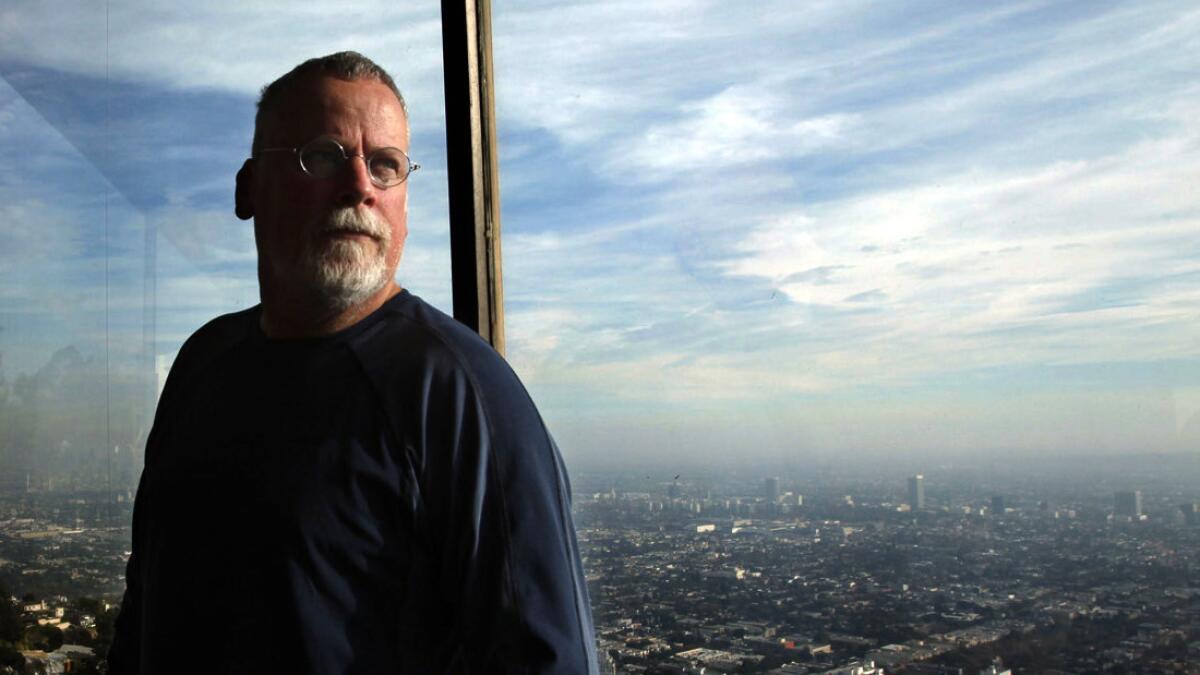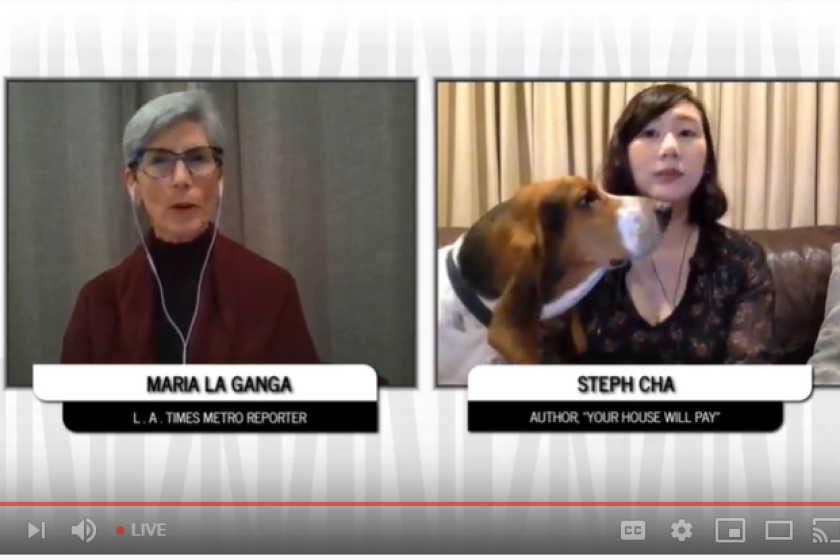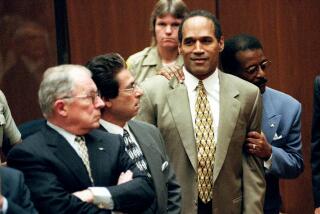Why L.A. is the dark heart of crime writing

Los Angeles is a madman’s prayer wrapped inside a murderous dream.
It’s homeless on sidewalks and hustlers in the hills. It’s laborers and housekeepers, and billboards of lust, dystopia, apes, robots, Chewbaccas, Kim and Kanye, and Lady Gaga’s newest thing. It’s clear skies, no mosquitoes and laser-sculpted people with money, hedgerows and sins. A crime writer can make of it what he or she wants, like “Westworld” or a lover who gives you a kiss and a key, and one day changes the locks.
The city is the seething, sexy capital of noir. It is an illicit urge — a trick of possibility — slinking like a con man’s ruse into a novelist’s imagination. Transgressions pile up and the skyline is newly pricked, rising above vintage bungalows that sell for a million-plus and are gutted and remade for the conceits and dark angels of a new century.
Raymond Chandler knew Los Angeles was both lie and delusion. A bitter candyland, where paradise betrays, and men talk tough and women know the score. The city is desire and the demons beneath, a metropolis where virtue is transactional and shifting façades, like so many Hollywood sets, mask cruelty and indifference. Not forever but long enough to make one wonder whether Michael Connelly’s reticent and resilient Det. Harry Bosch will in the end find peace in his creed: “Everybody counts or nobody counts.”

Tour L.A. through the eyes of novelist Michael Connelly’s relentless detective, Harry Bosch.
“Telling something new about this place is what defines a great L.A. crime novel,” said Connelly, whose new book, “The Night Fire,” which pairs Bosch with Det. Renee Ballard, will be published Tuesday. “Not imitating what has been done in the past but taking those influences and inspirations, putting it in a blender with your own experiences and ideas, mixing on purée and pouring out something unique about this unique place.”
Los Angeles is at once a stereotype and piercingly its own, a mountain lion caught in traffic, a cumbia gliding through a hymn. It is a surfer’s sunset, a Santa Ana gust, a wildfire, a canyon howl, a glittering mural, a whispered hate, a body in a street. Like the men and women in its crime novels, the city, a multicultural diary of splendor and hurt, is its own character: grisly, sinister, smooth, sly, urbane, verbose, sparse, fatalistic, celebratory, hopeful and occasionally as doomed as James Ellroy’s “Black Dahlia.”
“All books about Los Angeles have a little bit of noir in them. The city, after all, demands it,” said David L. Ulin, a former Times books editor, author and editor of “Writing Los Angeles: A Literary Anthology.” “This is a place where many people come out of their aspiration — to get famous, to get rich, to get away. Noir is what happens when they don’t get what they’re looking for; noir is what happens in the aftermath ... when desperation sets in. That’s one of the central stories of Los Angeles.”
Writers and readers have many takes on what makes the definitive L.A. crime novel: “An L.A. noir book must unfold in the darkness of L.A,” said T. Jefferson Parker, whose latest book is “The Last Good Guy.” “It can be old or contemporary. It’s a mood, not a time.” Steph Cha, author of “Your House Will Pay,” a compelling new novel exploring the city’s racial tensions, is less particular: “I figure if it’s got crime in it, and it takes place in Los Angeles, it qualifies.”
The city’s noir is a puzzle of flawed heroes and devious interlopers: cops, private eyes, assassins, gamblers, schemers and femme fatales looking not so much for absolution as for a reckoning that will edge them through another day. Or not. From Philip Marlowe to Easy Rawlins, crime novel sleuths know that human nature, whether in Watts or Beverly Hills, is balanced between reward and tragedy, and that a soul — its tender wants, grievous yearnings and amoral fascinations — is a peculiar, hard-to-reconcile thing.
“I’ve always been drawn to the beautiful loser or the unwitting dupe,” said Tod Goldberg, author of “Gangster Nation.” “Characters like Roy Dillon in Jim Thompson’s ‘The Grifters’ or, of course, Tod Hackett in Nathanael West’s ‘The Day of the Locust,’ characters too smart by half to be wrapped up in the lives they’ve chosen. Issues of identity have always run through the best crime novels of our region, each of us ruled by who we think we are versus who reality has shown us to be, difficult circumstances in a world where seemingly half the people we encounter are employed in make-believe for their living.”
Chandler’s wry cynicism, tinged sadness and clever asides (“Such a lot of guns around town and so few brains”) infused his novels, including “The Big Sleep” and “The Long Goodbye,” with a hard-boiled sophistication that would influence crime writers and filmmakers for generations. The 1946 movie version of his Marlowe (Humphrey Bogart/“The Big Sleep”) was a near perfect union of book and film, one that showed how indivisible noir literature and cinema would become even as crime movies lost their suave double entendres to expletives and gratuitous gunplay.
“I don’t think there’s any other genre that is so intertwined as the crime genre with film and novel,” said Don Winslow, author of “The Border” and “The Cartel.” “You can’t separate them. They have been informed by each other from the time they started rolling the camera. Noir particularly. Look, I never sat in my office as a PI where a trumpet started and a long-legged blond walked into the room. It was my wife, and I was home with a jazz record on, but that soundtrack of noir informs me when I sit down to write.”
In more recent decades, voices from diverse communities have articulated the texture and resonance of the city’s multiethnic landscape. What defines Los Angeles is being shot through different prisms. Hector Tobar’s “The Tattooed Soldier” brings the enmities of the Guatemalan civil war to the L.A. riots. Japanese American novelist Joe Ide has sketched a wonderfully clever thinking-man’s sleuth in his “IQ” series. Cha has delivered Juniper Song, an edgy and inventive Korean American private investigator. Walter Mosley’s proud and enduring Rawlins — a World War II vet with a taste for real estate and temptation — journeys into racism and social inequities faced by African Americans.
The Rawlins books “present a side of L.A. so real that I have no doubt it exists,” said writer Bette Ross. “In my mind, I see streets of modest houses, some with rusted cars in the yard, some yards well-kept with flowers, hints about the people who live there. Personal expectations are built from different parameters. ... Justice is tempered by implacable, sometimes vicious reality.”
“For so many decades,” said Daniel Olivas, author and editor of the anthology “Latinos in Lotusland,” “people of color in Los Angeles really were nothing more than props and ugly stereotypes in ‘classic’ noir fiction.” He praised Yxta Maya Murray’s novel “Locas” for capturing the lives of Chicanas “living in the gang-ravaged Los Angeles neighborhood of Echo Park. ... But in this novel, women of color are at its center rather than being relegated to mere plot points, sexual conquests or incidental appearances.”
Raymond Chandler, Michael Connelly and beyond: 20 essential L.A. crime books
Reality here is a tease with a bullet, a come-on for a setup. In his 1981 novel, “A Savage Place,” Robert B. Parker called Los Angeles “the last hallucination, the dwindled fragment of — what had Fitzgerald called it? — ‘the last and greatest of all human dreams.’ It was where we’d run out of room, where the dream had run up against the ocean, and human voices woke us. Los Angeles was the butt end, where we’d spat it out with our mouths tasting of ashes, but a genial failure of a place for all that.”
It is the lonely heart beating inside the wreckage, where characters confront history and themselves, such as Jackie Ishida, a Japanese American woman in Nina Revoyr’s “Southland,” who examines the life of her grandfather in a story that is an intimate and sweeping look at Los Angeles’ diversity and danger. Like a smart dame — a derringer in her sequined clutch — outwitting a patsy, the story of the city is a protagonist’s search for answers no matter how unseemly.
“For me,” said Ide, “L.A. noir is about a lone, determined character, trying to find a way through a perilous, capricious, multilayered city. Sometimes to seek justice, sometimes just to survive.”

Los Angeles is America through refracted light. A soft glow needled with glare. The country looks west and sees a future that inspires and frightens, a city of progressive politics and immigrants, of homeless tents and Marvel fantasies; of God, flesh, tattoos, Cartier and lowriders. It is reluctant to confront its ills and restless in its contradictions, a place for itinerant souls to barter and bid and, depending on one’s luck, find sustenance, wealth or a glimmer of providence. That’s when shadows shift and bodies fall.
“We’re drawn to the feral qualities of the grasping, amoral Angelenos who populate classic L.A. noir,” write Kim Cooper and Richard Schave, who run Esotouric Tours, which explores the city’s lurid underbelly. “Strangers in town, free agents, they don’t feel the eyes of village elders upon them — they can do anything they dream here and get away with it or kill or die trying.”
An imagined crime here can spring from a sudden glimpse. The other day, where the 110 veers to the 105, a leopard-print high-heeled shoe sat alone on the roadside. A purple scarf lay in nearby weeds. Traffic raced past. Planes bound for LAX skimmed the distance. It was hazy, hot. Another day on the outskirts. The mind wandered, the way it does when the radio plays like a whisper. One wondered whose foot that shoe belonged to; whose neck was draped in that scarf, which rippled in a wind that blew west toward the runways and the ocean.
Fleishman’s latest novel is “My Detective.”
Authors Steph Cha and Joe Ide swapped crimes stories and favorite books during the L.A. Times Book Club’s first virtual event.
If you go
Author Michael Connelly joins the L.A. Times Book Club to discuss “The Night Fire.”
When: 7:30 p.m. Monday
Where: The Montalbán Theater, 161615 Vine St., Los Angeles
Info: latimes.com/bookclub
More to Read
Sign up for our Book Club newsletter
Get the latest news, events and more from the Los Angeles Times Book Club, and help us get L.A. reading and talking.
You may occasionally receive promotional content from the Los Angeles Times.








